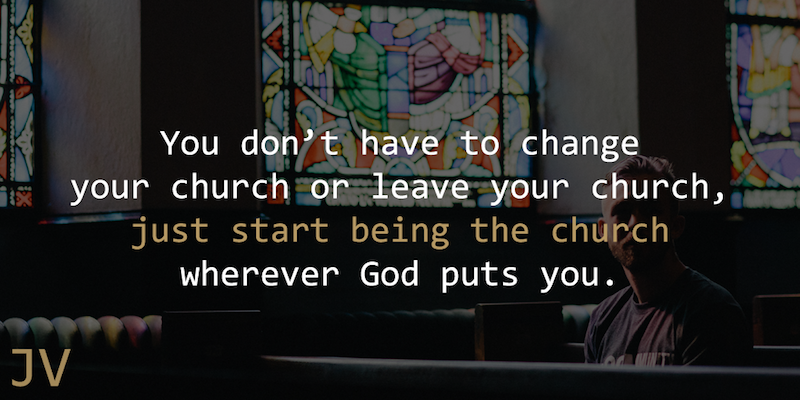
Recently, my friend Jeff Vanderstelt shared his heart on the Saturate Field Guide that he developed with Ben Connelly, another one of my friends and one of our regular authors at NewChurches.com. Here is the interview.
Q. How can an attractional church move towards being more missional using this book?
A. The book guides believers through a study whereby they will come to understand the gospel and its implications for discipleship and mission. As participants work through the daily study and exercises, they will learn to embrace their identity as God’s family, sent as servants and missionaries to the world. The guidebook is most effective when a small group of believers commit to go through it together. As they travel together through the study, not only will they be led to personally grow as God’s missionary people, but collectively they will learn to realign their lives together around God’s purposes and mission. The guide was designed to move people from being Sunday only believers to everyday disciples who make disciples together in community while on mission.
Q. How do we normalize mission in the life of my church?
A. First of all, we need to preach the gospel indicatives – What is true about 1) who God is as revealed by 2) what God has done (especially in and through the person and work of Jesus Christ) leading to understanding 3) who we are in Christ. Then, we need to help people see how believing the gospel leads to new behaviors. The indicatives of the gospel lead to the imperatives of obedience.
The reason this is key to normalizing mission in the church is because the church needs to understand that the outcome of the gospel is mission. God is a missionary God who sent his only son to rescue and redeem a people for his mission on the earth. God is missionary, and we are his missionary people. It begins with us understanding our true identity as God’s people. Charles Spurgeon was famous for saying: “Every Christian is either a missionary or an imposter.” There is not a category for non-missionary Christian. If you are a Christian, you are a missionary.
Next, as people begin to understand, believe and live out their identity as missionaries, they also need to be taught that the mission of making disciples happens in the everyday stuff of life – not just church events or mission trips. In fact, the best place for discipleship is not the church event, but the home, the café, at work, at play…where we do life.
And lastly, leaders need to model it for the church. They need to show others how to be on mission in the everyday stuff of life, share their struggles, teach from their own life on mission. The church generally follows their leaders pretty well. So, a church not on mission in the everyday stuff of life may very well just be following their leaders’ examples.
Q. What’s the best way to train up future leaders and church planters in my church?
A. I think formal training is helpful, but very insufficient. Most churches, Bible schools and seminaries focus mainly on formal study and training. But it’s simply not that effective by itself.
You need to embrace a life on life, life in community and life on mission approach to leadership development.
Life on life is the kind of discipleship and leadership development that is visible and accessible. People need to watch our lives – our marriages, our parenting, our interactions with believers and non-believers, neighbors, friends and co-workers. They need to see us handle conflict, address sin, work through our own sin and brokenness. And we need to see the lives of those we are developing. Everyone can look the part in a classroom or church event. We need to see each other in all of life in order to examine where we still need to grow.
We also need life in community discipleship. Too often leaders are developed in one-on-one relationships only to become like the one who developed them. However, we want people to look more like Christ, not us. Therefore, they need a community to disciple them. They need men and women and a diversity of gifts equipping them regularly.
And lastly, we need life on mission discipleship. Jesus said, “Follow me, and I will make you fishers of men.” He didn’t say “Show up to class and listen to me teach.” He developed them while on mission. They learned what discipleship looked like because he did it to them, and he did it in front of them. Then, he watched them do it and trained them while on mission. Eventually, they could do it without him physically present (though he was still present in their lives through the Spirit). We won’t develop strong gospel-centered, missionally driven, Spirit-led leaders unless we train them in the middle of the mission of making disciples who make disciples.
It needs to be said, that all of this without prayer and any of this without the power of the Spirit, is futile. A church, a leader, a person seeking to engage missionally without the power and direction of the Spirit of God is an exercise in futility. That is why the guide also directs the participants toward regular prayer.
The Spirit of God is the best discipler. As Jesus was sent empowered by the Spirit, so are we.
Next Steps:
- Pick up a copy of the Saturate Field Guide by Jeff Vanderstelt and Ben Connelly
- Click here to learn more about this book and get additional resources.
- Click here to read the book review I wrote for Christianity Today on Jeff Vanderstelt’s initial book, Saturate